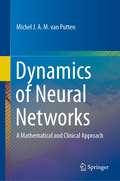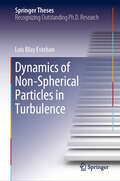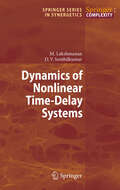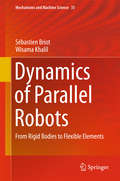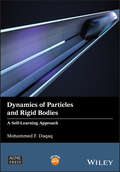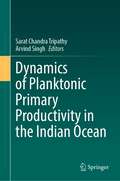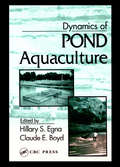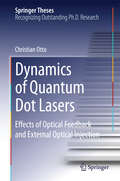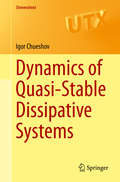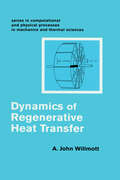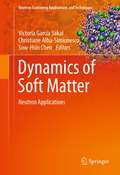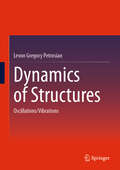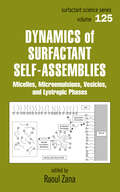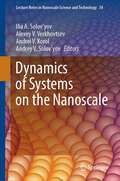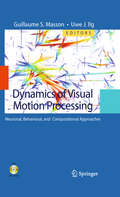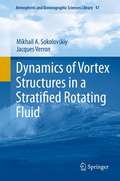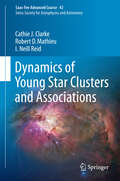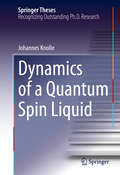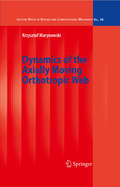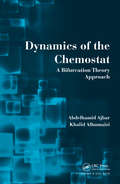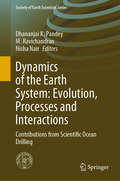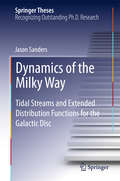- Table View
- List View
Dynamics of Multiphase Flows (Cambridge Series in Chemical Engineering)
by Liang-Shih Fan Chao Zhu Zhao YuUnderstand multiphase flows using multidisciplinary knowledge in physical principles, modelling theories, and engineering practices. This essential text methodically introduces the important concepts, governing mechanisms, and state-of-the-art theories, using numerous real-world applications, examples, and problems. Covers all major types of multiphase flows, including gas-solid, gas-liquid (sprays or bubbling), liquid-solid, and gas-solid-liquid flows. Introduces the volume-time-averaged transport theorems and associated Lagrangian-trajectory modelling and Eulerian-Eulerian multi-fluid modelling. Explains typical computational techniques, measurement methods and four representative subjects of multiphase flow systems. Suitable as a reference for engineering students, researchers, and practitioners, this text explores and applies fundamental theories to the analysis of system performance using a case-based approach.
Dynamics of Neural Networks: A Mathematical and Clinical Approach
by Michel J.A.M. van PuttenThis book treats essentials from neurophysiology (Hodgkin–Huxley equations, synaptic transmission, prototype networks of neurons) and related mathematical concepts (dimensionality reductions, equilibria, bifurcations, limit cycles and phase plane analysis). This is subsequently applied in a clinical context, focusing on EEG generation, ischaemia, epilepsy and neurostimulation. The book is based on a graduate course taught by clinicians and mathematicians at the Institute of Technical Medicine at the University of Twente. Throughout the text, the author presents examples of neurological disorders in relation to applied mathematics to assist in disclosing various fundamental properties of the clinical reality at hand. Exercises are provided at the end of each chapter; answers are included. Basic knowledge of calculus, linear algebra, differential equations and familiarity with MATLAB or Python is assumed. Also, students should have some understanding of essentials of (clinical) neurophysiology, although most concepts are summarized in the first chapters. The audience includes advanced undergraduate or graduate students in Biomedical Engineering, Technical Medicine and Biology. Applied mathematicians may find pleasure in learning about the neurophysiology and clinic essentials applications. In addition, clinicians with an interest in dynamics of neural networks may find this book useful, too.
Dynamics of Non-Spherical Particles in Turbulence (Springer Theses)
by Luis Blay EstebanThis book studies the dynamics of 2D objects moving through turbulent fluids. It examines the decay of turbulence over extended time scales, and compares the dynamics of non-spherical particles moving through still and turbulent fluids. The book begins with an introduction to the project, its aims, and its relevance for industrial applications. It then discusses the movement of planar particles in quiescent fluid, and presents the numerous methodologies used to measure it. The book also presents a detailed analysis of the falling style of irregular particles, which makes it possible to estimate particle trajectory and wake morphology based on frontal geometry. In turn, the book provides the results of an analysis of physically constrained decaying turbulence in a laboratory setting. These results suggest that large-scale cut-off in numerical simulations can result in severe bias in the computed turbulent kinetic energy for long waiting times. Combining the main text with a wealth of figures and sketches throughout, the book offers an accessible guide for all engineering students with a basic grasp of fluid mechanics, while the key findings will also be of interest to senior researchers.
Dynamics of Nonlinear Time-Delay Systems
by Dharmapuri Vijayan Senthilkumar Muthusamy LakshmananSynchronization of chaotic systems, a patently nonlinear phenomenon, has emerged as a highly active interdisciplinary research topic at the interface of physics, biology, applied mathematics and engineering sciences. In this connection, time-delay systems described by delay differential equations have developed as particularly suitable tools for modeling specific dynamical systems. Indeed, time-delay is ubiquitous in many physical systems, for example due to finite switching speeds of amplifiers in electronic circuits, finite lengths of vehicles in traffic flows, finite signal propagation times in biological networks and circuits, and quite generally whenever memory effects are relevant. This monograph presents the basics of chaotic time-delay systems and their synchronization with an emphasis on the effects of time-delay feedback which give rise to new collective dynamics. Special attention is devoted to scalar chaotic/hyperchaotic time-delay systems, and some higher order models, occurring in different branches of science and technology as well as to the synchronization of their coupled versions. Last but not least, the presentation as a whole strives for a balance between the necessary mathematical description of the basics and the detailed presentation of real-world applications.
Dynamics of Parallel Robots
by Wisama Khalil Sébastien BriotThis book starts with a short recapitulation on basic concepts, common to any types of robots (serial, tree structure, parallel, etc. ), that are also necessary for computation of the dynamic models of parallel robots. Then, as dynamics requires the use of geometry and kinematics, the general equations of geometric and kinematic models of parallel robots are given. After, it is explained that parallel robot dynamic models can be obtained by decomposing the real robot into two virtual systems: a tree-structure robot (equivalent to the robot legs for which all joints would be actuated) plus a free body corresponding to the platform. Thus, the dynamics of rigid tree-structure robots is analyzed and algorithms to obtain their dynamic models in the most compact form are given. The dynamic model of the real rigid parallel robot is obtained by closing the loops through the use of the Lagrange multipliers. The problem of the dynamic model degeneracy near singularities is treated and optimal trajectory planning for crossing singularities is proposed. Lastly, the approach is extended to flexible parallel robots and the algorithms for computing their symbolic model in the most compact form are given. All theoretical developments are validated through experiments.
Dynamics of Particles and Rigid Bodies: A Self-Learning Approach (Wiley-ASME Press Series)
by Mohammed F. DaqaqA unique approach to teaching particle and rigid body dynamics using solved illustrative examples and exercises to encourage self-learning The study of particle and rigid body dynamics is a fundamental part of curricula for students pursuing graduate degrees in areas involving dynamics and control of systems. These include physics, robotics, nonlinear dynamics, aerospace, celestial mechanics and automotive engineering, among others. While the field of particle and rigid body dynamics has not evolved significantly over the past seven decades, neither have approaches to teaching this complex subject. This book fills the void in the academic literature by providing a uniquely stimulating, “flipped classroom” approach to teaching particle and rigid body dynamics which was developed, tested and refined by the author and his colleagues over the course of many years of instruction at both the graduate and undergraduate levels. Complete with numerous solved illustrative examples and exercises to encourage self-learning in a flipped-classroom environment, Dynamics of Particles and Rigid Bodies: A Self-Learning Approach: Provides detailed, easy-to-understand explanations of concepts and mathematical derivations Includes numerous flipped-classroom exercises carefully designed to help students comprehend the material covered without actually solving the problem for them Features an extensive chapter on electromechanical modelling of systems involving particle and rigid body motion Provides examples from the state-of-the-art research on sensing, actuation, and energy harvesting mechanisms Offers access to a companion website featuring additional exercises, worked problems, diagrams and a solutions manual Ideal as a textbook for classes in dynamics and controls courses, Dynamics of Particles and Rigid Bodies: A Self-Learning Approach is a godsend for students pursuing advanced engineering degrees who need to master this complex subject. It will also serve as a handy reference for professional engineers across an array of industrial domains.
Dynamics of Particles and Rigid Bodies: A Systematic Approach
by Anil V. RaoDynamics of Particles and Rigid Bodies: A Systematic Approach is intended for undergraduate courses in dynamics. This work is a unique blend of conceptual, theoretical, and practical aspects of dynamics generally not found in dynamics books at the undergraduate level. In particular, in this book the concepts are developed in a highly rigorous manner and are applied to examples using a step-by-step approach that is completely consistent with the theory. In addition, for clarity, the notation used to develop the theory is identical to that used to solve example problems. The result of this approach is that a student is able to see clearly the connection between the theory and the application of theory to example problems. While the material is not new, instructors and their students will appreciate the highly pedagogical approach that aids in the mastery and retention of concepts. The approach used in this book teaches a student to develop a systematic approach to problem-solving. The work is supported by a great range of examples and reinforced by numerous problems for student solution. An Instructor's Solutions Manual is available.
Dynamics of Planktonic Primary Productivity in the Indian Ocean
by Arvind Singh Sarat Chandra TripathyThis volume compiles recent research on phytoplankton primary productivity (PP) in the Indian Ocean to provide an understanding and consolidation of the driving mechanisms of PP variability in diverse oceanic ecosystems globally. The book aims to facilitate a holistic overview of the research carried out in this field in various oceanic realms such as Indian coastal and oceanic waters (estuaries, coastal waters, Bay of Bengal, Arabian Sea, Indian Ocean). The contents of this book also address the United Nations sustainable development goals i.e., SDG 13 (Climate Action) and SDG 14 (Life below Water), with a focus on the impacts of climate change oceanic ecosystems. The book can serve as a comprehensive baseline of information for researchers studying planktonic primary productivity and biogeochemistry-related research in the above-mentioned marine ecosystems and other global oceans. It is intended to attract the attention of researchers, professionals, undergraduate and graduate oceanography students, and policy makers in the field of marine sciences.
Dynamics of Pond Aquaculture
by Claude E. Boyd Hillary S. EgnaThe culmination of over a decade's worth of research by the Pond Dynamics/Aquaculture Collaborative Research Support Program (CRSP), Dynamics of Pond Aquaculture not only explains the physical, chemical, and biological processes that interact in pond culture systems, but also presents real-world research findings and considers the people who depend on these systems. This book uses data from CRSP field research sites in East Africa, Southeast Asia, Central America, and North America to present a complete picture of the pond system and the environment in which it exists.A thorough study of the principles and practices of aquaculture, the book reflects the state of the art in pond aquaculture and incorporates recent advances that have changed the science in the last decade or so. It provides a thorough review of the many methods, techniques, and ideas that comprise this complex and fascinating area of study.
Dynamics of Quantum Dot Lasers
by Christian OttoThis thesis deals with the dynamics of state-of-the-art nanophotonic semiconductor structures, providing essential information on fundamental aspects of nonlinear dynamical systems on the one hand, and technological applications in modern telecommunication on the other. Three different complex laser structures are considered in detail: (i) a quantum-dot-based semiconductor laser under optical injection from a master laser, (ii) a quantum-dot laser with optical feedback from an external resonator, and (iii) a passively mode-locked quantum-well semiconductor laser with saturable absorber under optical feedback from an external resonator. Using a broad spectrum of methods, both numerical and analytical, this work achieves new fundamental insights into the interplay of microscopically based nonlinear laser dynamics and optical perturbations by delayed feedback and injection.
Dynamics of Quasi-Stable Dissipative Systems
by Igor ChueshovThis book is devoted to background material and recently developed mathematical methods in the study of infinite-dimensional dissipative systems. The theory of such systems is motivated by the long-term goal to establish rigorous mathematical models for turbulent and chaotic phenomena. The aim here is to offer general methods and abstract results pertaining to fundamental dynamical systems properties related to dissipative long-time behavior. The book systematically presents, develops and uses the quasi-stability method while substantially extending it by including for consideration new classes of models and PDE systems arising in Continuum Mechanics. The book can be used as a textbook in dissipative dynamics at the graduate level. Igor Chueshov is a Professor of Mathematics at Karazin Kharkov National University in Kharkov, Ukraine.
Dynamics of Regenerative Heat Transfer
by John A WillmottThe author, a respected authority on heat recovery, provides up-to-date and comprehensive coverage of the modelling of the process of heat transfer embodied in regenerative devices. He brings together material on storage and thermal generators and gives great emphasis to non-linear problems including the representation of temperature dependence of thermophysical properties involved.; In ten dynamic chapters, you will find coverage of: the storage of heat in packing; the Single Blow problem; basic concepts in counterflow thermal regenerators; counterflow regenerators; finite conductivity models; non-linear models of counterflow regenerators; transient response of counterflow regenerators; and parallel flow regenerators. Bringing together material developed over the past twenty years, the book will be of great interest to mechanical and chemical engineers as well as applied mathematicians concerned with models of heat transfer processes.
Dynamics of Soft Matter: Neutron Applications (Neutron Scattering Applications and Techniques)
by Christiane Alba-Simionesco Sow Hsin Chen Victoria Garcia SakaiDynamics of Soft Matter: Neutron Applications provides an overview of neutron scattering techniques that measure temporal and spatial correlations simultaneously, at the microscopic and/or mesoscopic scale. These techniques offer answers to new questions arising at the interface of physics, chemistry, and biology. Knowledge of the dynamics at these levels is crucial to understanding the soft matter field, which includes colloids, polymers, membranes, biological macromolecules, foams, emulsions towards biological & biomimetic systems, and phenomena involving wetting, friction, adhesion, or microfluidics. Emphasizing the complementarities of scattering techniques with other spectroscopic ones, this volume also highlights the potential gain in combining techniques such as rheology, NMR, light scattering, dielectric spectroscopy, as well as synchrotron radiation experiments. Key areas covered include polymer science, biological materials, complex fluids and surface science.
Dynamics of Structures: Oscillations/Vibrations
by Levon Gregory PetrosianThis book presents dynamic calculation in the context of structural mechanics and civil engineering. It explains the process of testing the strength of structures and determining the dynamic displacements, velocities, and accelerations, whose values; as measured by the influence of vibrations on people, and certain types of precision equipment, such as measuring instruments, high-precision machines, and equipment for microelectronics production, should not exceed the permissible limits. The first part of the book (15 chapters) is ideal as a textbook for advanced undergraduate, graduate, or post-graduate students taking their first course in structural dynamics. This text can be used for two semesters. In addition, the book will serve as a primary reference for practicing engineers and research workers, as well as a self-study guide for students, researchers, and professional engineers. The second part of the book (chapter 16 onwards) is intended mainly for professionals and specialists in the field of dynamics of structures and related areas.
Dynamics of Surfactant Self-Assemblies: Micelles, Microemulsions, Vesicles and Lyotropic Phases
by Raoul ZanaDynamics of Surfactant Self-Assemblies explains the dynamics of micellar equilibria, tracking surfactant exchange, and micelle formation/breakdown processes. Highlighting the structural similarities of amphiphilic block copolymers to surfactants, this volume elucidates the dynamics of more complex self-assemblies that surfactants and amphiphilic bl
Dynamics of Systems on the Nanoscale (Lecture Notes in Nanoscale Science and Technology #34)
by Andrey V. Solov’yov Ilia A. Solov’yov Alexey V. Verkhovtsev Andrei V. KorolThis book presents the structure formation and dynamics of animate and inanimate matter on the nanometre scale. This is a new interdisciplinary field known as Meso-Bio-Nano (MBN) science that lies at the intersection of physics, chemistry, biology and material science. Special attention in the book is devoted to investigations of the structure, properties and dynamics of complex MBN systems by means of photonic, electronic, heavy particle and atomic collisions. This includes problems of fusion and fission, fragmentation, surfaces and interfaces, reactivity, nanoscale phase and morphological transitions, irradiation-driven transformations of complex molecular systems, collective electron excitations, radiation damage and biodamage, channeling phenomena and many more. Emphasis in the book is placed on the theoretical and computational physics research advances in these areas and related state-of-the-art experiments. Particular attention in the book is devoted to the utilization of advanced computational techniques and high-performance computing in studies of the dynamics of systems.
Dynamics of Underactuated Multibody Systems
by Robert SeifriedUnderactuated multibody systems are intriguing mechatronic systems, as they posses fewer control inputs than degrees of freedom. Some examples are modern light-weight flexible robots and articulated manipulators with passive joints. This book investigates such underactuated multibody systems from an integrated perspective. This includes all major steps from the modeling of rigid and flexible multibody systems, through nonlinear control theory, to optimal system design. The underlying theories and techniques from these different fields are presented using a self-contained and unified approach and notation system. Subsequently, the book focuses on applications to large multibody systems with multiple degrees of freedom, which require a combination of symbolical and numerical procedures. Finally, an integrated, optimization-based design procedure is proposed, whereby both structural and control design are considered concurrently. Each chapter is supplemented by illustrated examples.
Dynamics of Visual Motion Processing
by Guillaume S. Masson Uwe J. IlgMotion processing is an essential piece of the complex brain machinery that allows us to reconstruct the 3D layout of objects in the environment, to break camouflage, to perform scene segmentation, to estimate the ego movement, and to control our action. Although motion perception and its neural basis have been a topic of intensive research and modeling the last two decades, recent experimental evidences have stressed the dynamical aspects of motion integration and segmentation. This book presents the most recent approaches that have changed our view of biological motion processing. These new experimental evidences call for new models emphasizing the collective dynamics of large population of neurons rather than the properties of separate individual filters. Chapters will stress how the dynamics of motion processing can be used as a general approach to understand the brain dynamics itself.
Dynamics of Vortex Structures in a Stratified Rotating Fluid
by Jacques Verron Mikhail A. SokolovskiyThis book presents an extensive analysis of the dynamics of discrete and distributed baroclinic vortices in a multi-layer fluid that characterizes the main features of the large and mesoscales dynamics of the atmosphere and the ocean. It widely covers the case of hetonic situations as well as the case of intrathermocline vortices that are familiar in oceanographic and of recognized importance for heat and mass transfers. Extensive typology of such baroclinic eddies is made and analysed with the help of theoretical development and numerical computations. As a whole it gives an overview and synthesis of all the many situations that can be encountered based on the long history of the theory of vortex motion and on many new situations. It gives a renewed insight on the extraordinary richness of vortex dynamics and open the way for new theoretical, observational and experimental advances. This volume is of interest to experts in physical oceanography, meteorology, hydrodynamics, dynamic systems, involved in theoretical, experimental and applied research and lecturers, post-graduate students, and students in these fields.
Dynamics of Young Star Clusters and Associations
by Cathie Clarke Robert D. Mathieu Iain Neill ReidMichael R. Meyer Laurent Eyer Cameron P.M. BellWhere do most stars (and the planetary systems that surround them) in the Milky Way form? What determines whether a young star cluster remains bound (such as an open or globular cluster), or disperses to join the field stars in the disc of the Galaxy? These questions not only impact understanding of the origins of stars and planetary systems like our own (and the potential for life to emerge that they represent), but also galaxy formation and evolution, and ultimately the story of star formation over cosmic time in the Universe. This volume will help readers understand our current views concerning the answers to these questions as well as frame new questions that will be answered by the European Space Agency's Gaia satellite that was launched in late 2013. The book contains the elaborated notes of lectures given at the 42nd Saas-Fee Advanced Course "Dynamics of Young Star Clusters & Associations" by Cathie Clarke (University of Cambridge) who presents the theory of star formation and dynamical evolution of stellar systems, Robert Mathieu (University of Wisconsin) who discusses the kinematics of star clusters and associations, and I. Neill Reid (S pace Telescope Science Institute) who provides an overview of the stellar populations in the Milky Way and speculates on from whence came the Sun. As part of the Saas-Fee Advanced Course Series, the book offers an in-depth introduction to the field serving as a starting point for Ph. D. research and as a reference work for professional astrophysicists.
Dynamics of a Quantum Spin Liquid
by Johannes KnolleThis thesis presents an exact theoretical study of dynamical correlation functions in different phases of a two-dimensional quantum spin liquid. By calculating the dynamical spin structure factor and the Raman scattering cross section, this thesis shows that there are salient signatures--qualitative and quantitative--of the Majorana fermions and the gauge fluxes emerging as effective degrees of freedom in the exactly solvable Kitaev honeycomb lattice model. The model is a representative of a class of spin liquids with Majorana fermions coupled to Z2 gauge fields. The qualitative features of the response functions should therefore be characteristic for this broad class of topological states.
Dynamics of the Axially Moving Orthotropic Web
by Krzysztof MarynowskiA material continuum moving axially at high speed can be met in numerous different technical applications. These comprise band saws, web papers during manufacturing, processing and printing processes, textile bands during manufacturing and processing, pipes transporting fluids, transmission belts as well as flat objects moving at high speeds in space. In all these so varied technical applications, the maximum transport speed or the transportation speed is aimed at in order to increase efficiency and optimize investment and performance costs of sometimes very expensive and complex machines and installations. The dynamic behavior of axially moving systems very often hinders from reaching these aims. The book is devoted to dynamics of axially moving material objects of low flexural stiffness that are referred to as webs. Webs are moving at high speed, for example, in paper production the paper webs are transported with longitudinal speeds of up to 3000 m/min. Above the critical speed one can expect various dynamical instabilities mainly of divergent and flutter type. The up-to-date state of investigations conducted in the field of the axially moving system dynamics is presented in the beginning of the book. Special attention is paid on nonlinear dynamic investigations of translating systems. In the next chapters various mathematical models that can be employed in dynamic investigations of such objects and the results of analysis of the dynamic behavior of the axially moving orthotropic material web are presented. To make tracing the dynamic considerations easier, a paper web is the main object of investigations in the book.
Dynamics of the Chemostat: A Bifurcation Theory Approach
by Abdelhamid Ajbar Khalid AlhumaiziA ubiquitous tool in mathematical biology and chemical engineering, the chemostat often produces instabilities that pose safety hazards and adversely affect the optimization of bioreactive systems. Singularity theory and bifurcation diagrams together offer a useful framework for addressing these issues. Based on the authors' extensive work in this
Dynamics of the Earth System: Contributions from Scientific Ocean Drilling (Society of Earth Scientists Series)
by Dhananjai K. Pandey M. Ravichandran Nisha NairThis book highlights Indian scientific endeavours and contributions to answering the vast multitude of questions posed by our changing environment. The International Ocean Discovery Program (IODP) explores Earth’s history and dynamics using deep ocean drilling platforms to recover the data locked inside seafloor sediments and rocks. Since 2009, Indian scientists have been actively engaged in these expeditions. Scientists from various Earth Science disciplines have seized this opportunity to offer their expertise in order to help unravel the mysteries of the past – by delving deep into the valuable sedimentary records of our oceans. This book presents a compilation of some of their most important findings to motivate and encourage young minds for their enhanced role in the cutting edge science of ocean drilling.
Dynamics of the Milky Way
by Jason SandersThis work presents a study of methods useful for modeling and understanding dynamical systems in the Galaxy. A natural coordinate system for the study of dynamical systems is the angle-action coordinate system. New methods for the approximation of the action-angle variables in general potentials are presented and discussed. These new tools are applied to the construction of dynamical models for two of the Galaxy's components: tidal streams and the Galactic disc. Tidal streams are remnants of tidally stripped satellites in the Milky Way that experience the effects of the large scale structure of the Galactic gravitational potential, while the Galactic disc provides insights into the nature of the Galaxy near the Sun. Appropriate action-based models are presented and discussed for these components, and extended to include further information such as the metallicity of stars.

